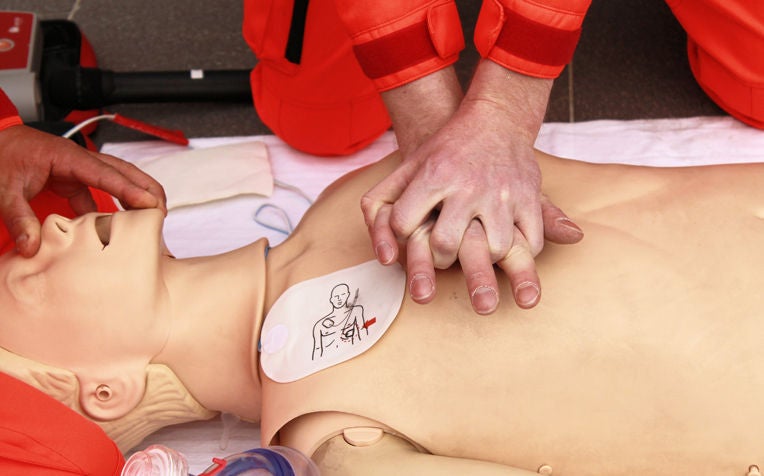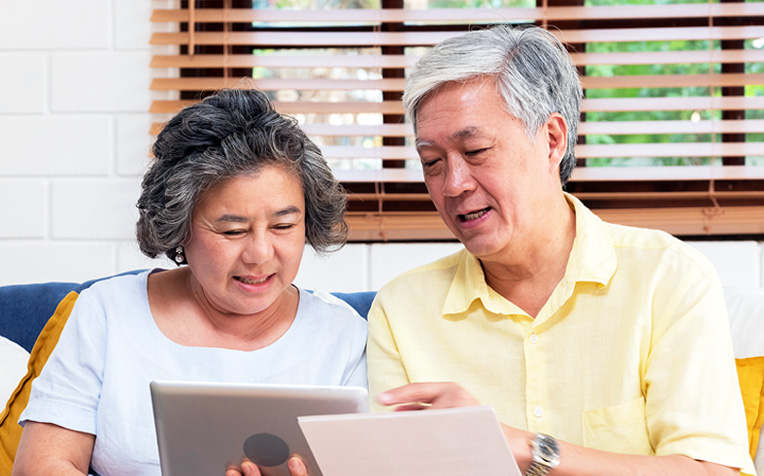
Would you DARE to save a heart? Here’s what you need to know about sudden cardiac arrest.
What to do if you witness someone collapse in front of you?
Here is a step-by-step guide on what you should do:
- Call 995 and stay on the line.
- Check if it is safe to approach the victim; watch for road hazards, etc.
- Tell someone to get an Automated External Defibrillator (AED).
- If possible carefully lay the victim flat on a hard surface like the ground.
- Check for breathing: Look for chest movement, listen for breath sounds and feel for breathing movements.
- If the person is not breathing normally, place your hands in the centre of the chest, between the nipples.
- Using the heel of your palm, push hard and fast. You should push at a rate of 100 compressions a minute, 5cm deep.
- Continue doing cardiopulmonary resuscitation (CPR) as guided by the 995 medical dispatcher until help arrives.
Heart attacks and sudden cardiac arrest (SCA) are not the same
| Condition | Heart Attack | Sudden Cardiac Arrest |
| Emergency condition? | Yes, call 995 (get AED just in case) | Yes, call 995 (get AED just in case) |
| Is the victim conscious? | Yes, usually | No |
| Able to speak? | Yes, possible | No |
| Breathing normally? | Yes, usually, but some problem | No |
| Has a chance to survive? | Yes, unless massive attack | Poor but survival is greatly improved by first responder resuscitation. Do CPR and get an AED immediately. |
DARE programme
Sudden cardiac arrest (SCA) is a medical emergency that requires immediate response. Such a response can be delivered by anyone. That is what the Dispatcher-Assisted First Responder (DARE) programme wants everyone to understand.
Out-of-hospital cardiac arrests (OHCA)
Sudden cardiac arrest is usually lethal, but ‘daring’ cities across the world are improving survival thanks to the involvement of bystanders.
SCA occurs most frequently outside of the hospital. As such, we classify all these events as “out-of-hospital cardiac arrests” (OHCA). In Singapore, about 70 per cent of such cardiac arrests occur in residential areas. The rest happen in public places such as business districts, airports or shopping malls.
OHCA are an important public health issue. With an ageing Singapore population, and chronic diseases such as high blood pressure, high cholesterol, and diabetes on the rise, the risk of OHCA is also increasing.
These OHCA also occur among middle-aged, wage-earning members of our population. This can have a devastating effect on a family. Consequences can be particularly dire when the main wage-earner of the family dies.
In the case of sudden cardiac arrest, a victim has only minutes in which steps can be taken to revive him or her. No matter how fast the fastest ambulance is, it cannot arrive on the scene faster than the bystander who witnesses the collapse.
The DARE programme is based on a well-established concept of bystanders delivering CPR and AED shocks whilst being coached by a medical dispatcher over the telephone. This gives the victim some chance of survival whilst an ambulance is sent to the scene. For instance, in some cities of Scandinavia, USA and Japan, resuscitation rates for incidents where bystanders initiated CPR are as high as 60 per cent.
No mouth-to-mouth required
Traditional CPR is usually taught as 30 compressions and 2 breaths every cycle. But it is well-known that bystanders often hesitate or even refuse to intervene because they are not keen to perform mouth-to-mouth ventilation.
DARE teaches hands-only CPR, which is as effective as traditional CPR for adults in the initial minutes after a victim collapses. What is critical in an OHCA event is that good quality chest compressions begin immediately to circulate oxygenated blood to vital organs such as the brain until paramedics can arrive on the scene and take over resuscitation.
However, in the case of infants and drowning victims suffering cardiac arrests, bystanders are still encouraged and coached to give ventilations. Another key component is the availability of an AED to shock the heart back to a normal beating rhythm.
DARE core concepts
DARE is looking to bring all these components together in a way that allows anyone to step up and help. DARE is a 45-minute awareness training that teaches three core principles. If you see someone collapse and the person is not breathing normally:
- Call 995 and stay on the line,
- Start chest compressions by pushing hard and fast, and
- Get an AED to the victim and apply it as fast as possible.

The beauty of the DARE programme is that it compresses first responder training by using a 12-minute video and guided hands-on practice for the balance of the session. The idea is not to replace traditional CPR/AED certification, but rather to familiarise everyone with what they should do if they witness someone collapse.
Would you DARE to step up? You may be that person whose action means the world to a victim, their family and friends.
Follow us on instagram @daretosave_sg #daretosaveaheart
Or find us on facebook: Dispatcher-Assisted first Responder: DARE
For inquiries, email DARE at: DARE_programme@sgh.com.sg

Ref: Q15


















 Get it on Google Play
Get it on Google Play